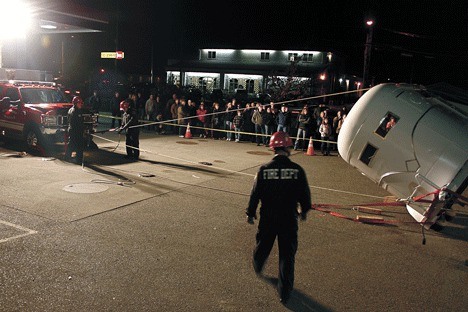Greater peace of mind is in store for Whidbey Island’s large animal owners.
Thanks to some forward thinking and fundraising by the Equine Emergency Rescue Team, also called EERT, and Island County Backcounty Horsemen, there’s an island-wide movement to establish a network of first responders in case of an accident involving large animals.
The North, Central and South Whidbey fire and rescue departments are also tied to the effort.
Late last year EERT and Island County Backcounty Horsemen sponsored three firefighters, one from each district, to attend a large animal rescue workshop at the Race Road Fire Station.
“The idea is to train the future trainers,” said EERT member Jerry Lloyd, in hopes that the scholarship recipients would share the new skills with their cohorts.
And that’s just what happened.
North Whidbey Fire and Rescue Chief Marv Koorn supports the training program. In addition to the scholarship, the north-end department paid for a second person to attend the workshop. Firefighters Scott Lanier and Dustin Amundson took the class and brought the training back to their department.
Word spread that North Whidbey Fire and Rescue could use an old horse trailer for drills, so Blazing Saddles 4-H Club donated one.
The trailer sat rusted and unused in a field for over a year, said Michelle Brookshier, the mother of a Blazing Saddles member.
“I hardly recognized it,” she said of the freshly painted trailer with a large NWFR decal and small, rectangular Blazing Saddles sticker.
Northenders got a live preview of the North Whidbey Fire and Rescue team’s expertise on the evening of Jan. 20 as lead rope technician Lanier and nine members of the department’s high angle rescue team demonstrated their ability to right a flipped horse trailer in the parking lot of Skagit Farmer’s Supply Co-op on Highway 20.
The demo in the heart of Oak Harbor drew a crowd of more than 100 onlookers and followed an “Equine First Aid Kit” clinic by Mount Vernon veterinarian Dr. Ken Leisher, who discussed the basic supplies needed to stabilize the animal until professional help arrives.
“You’ve got to make due with what you have,” he said. It’s nearly impossible to pack it all, so it’s important to stock versatile materials in the emergency kit.
Lanier and EERT member Randy Diefert followed Leisher’s seminar with a “how to” harness-tying demonstration. The pair used a length of fire hose to fashion an emergency harness that can be used to lift a large animal out of a precarious situation.
Last month Lanier tested his skills on a small scale during a canine rescue at Polnell Point.
“I whipped it right around a Labrador and lifted him right out of there,” Lanier told the crowd while he demonstrated how to tie the harness on a life-sized horse mannequin.
“Ruger,” a yellow lab, ran over the side of a bluff riddled with prickly blackberry bushes and required the help of North Whidbey Fire and Rescue to get back on solid ground.
Large animal rescue equipment is expensive, said EERT member Jerry Lloyd. The group aims to raise $3,500 to supply the north and south fire and rescue teams with the basic tools.
“Tonight is kind of like watching PBS,” he told the audience. “We cannot fund this program without donations.”
Aside from this new partnership with island rescue personnel, EERT is working to establish a community of on-call large animal rescuers who live on the island.
In addition to their communication with island fire and rescue personnel, EERT hopes to establish a network of individual first-responders who may have more extensive knowledge of large animal behavior and can assist the firemen with animal rescue.
Ideally, these people will be familiar with the local horse community, have training, be tied to ICOM or 911 and assist emergency personnel if there’s an accident, Lloyd said.
Although these wrecks are rare, trained responders can bridge the gap between life and death for the people and animals involved.
It doesn’t take much for an animal to get stuck in a soft low-tide flat, slip off a steep bluff trail, get stuck in a tight spot, or find some other trouble.
There’s long been a need for trained large animal rescue personnel on the island, Jerry Lloyd said, but it wasn’t until late last year that a group mobilized to do something about it.
EERT formed after a lecture by Dr. Leisher about his experience at an animal rescue workshop in Kentucky, said Connie Lloyd, an EERT member and secretary of the Island County Backcountry Horsemen.
“Horse owners were just so concerned,” Connie said of the previous lack of large animal rescue expertise on an island full of horse and livestock. “Accidents are inevitable.”
Although people will always come before animals, each department now has at least one member who’s trained to rescue large animals. Though EERT’s fundraising, the north and south departments will soon have the necessary equipment.
By the end of Wednesday night, they’d collected $1,763, just over half-way to their goal.
Thanks to the help of EERT, Island County Backcounty Horsemen, Blazing Saddles 4-H Club and large animal owners living on the island, North Whidbey Fire and Rescue is better trained and equipped for large animal rescue.
For more information about the Emergency Equine Rescue Team, or to make a donation, contact Jerry and Connie Lloyd at jerrytoy@whidbey.com.



